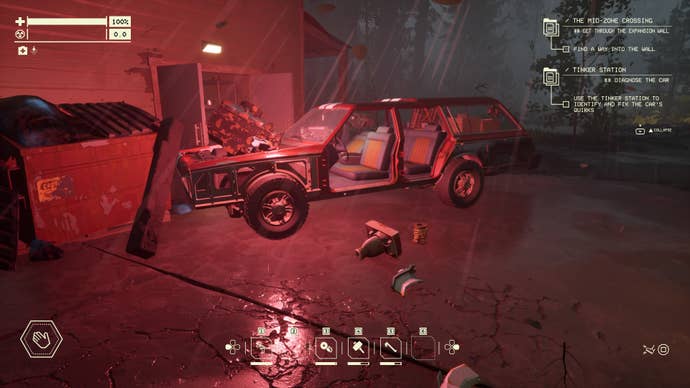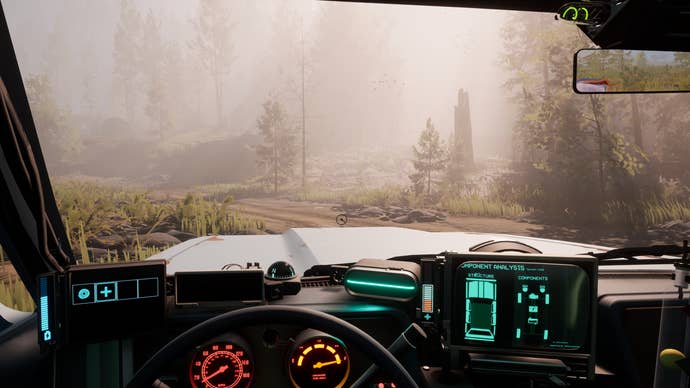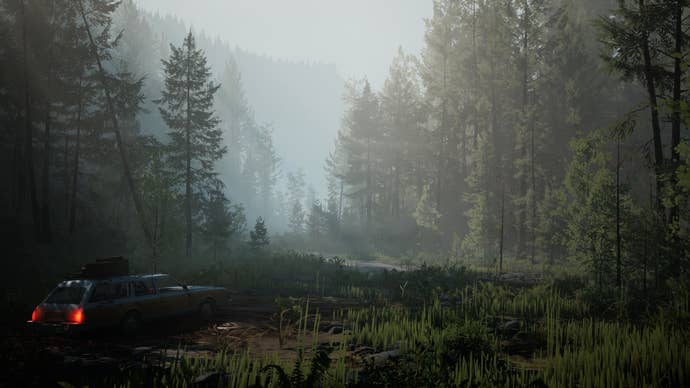Pacific Drive isn’t just a good driving game - it’s the antidote to your daily commute
All it takes to put an end to our automotive alienation is a nice station wagon and a ride down apocalypse avenue.
With a flash of light, the car warps back into existence. It gently rolls forwards, before coming to a sudden halt with a metallic thud, as it bumps into a dumpster. I try to throw the beaten and battered thing into reverse, so I can pull it into the garage.
It doesn’t budge when I touch the pedals. Confused, I get out and walk around to open the bonnet. There is no bonnet. More importantly, there’s no engine in the engine bay.
My latest trip into Pacific Drive’s Olympic Exclusion Zone has gone even worse than I thought.
It’s at this point, when you’re faced with an automobile that’s little more than a useless skeleton, a twisted sculpture reflecting your failure not to drive into trees, avoid obvious hazards or run from the storm quite fast enough, that you might feel a bit like giving up. But, despite my status as someone who’s annoyingly prone to reach for the reload save button when something’s gone really wrong for me in a game, I never have.
Instead, I’ve sought aid from my friendly neighbourhood dumpster, ground up the helpful goodies left just outside the auto shop with my scrapper, and set about patching my beloved automobile back together. I’ve done what Pacific Drive is really about - not actually driving, but preparing to go for a drive. Now, before we go any further, I’ll admit that I am, for better or worse, a car person.
I regularly sit or stand on a sunday and watch them go around in circles quite fast, I know my AC Cobras from my MG ZRs, and I’ve been known to enjoy at least the first few Fast and Furious films. You know, the ones about driving fast and stealing VCRs, as opposed to the ones about vast international conspiracies involving MI6 and the CIA. That said, when it comes to actually owning my own car, one that I’ve got to use for commuting about and hauling stuff back from the shops, I’ve developed what I can only refer to as car person imposter syndrome. The thing straight up terrifies me.
I can barely bring myself to read through a Haynes manual or attempt any kind of maintenance that’s beyond changing a bulb or blowing up the tires. I think the reason why is this - I can’t deal with what the consequences could be if something goes really, really wrong with it. And since, like the majority of the cars on the roads, it’s a used one that’s been around the block a few times, it’s prone to regularly developing new little quirks or issues that quickly get me panicking that, oh boy, this could be the time something’s really, really wrong with it.

In Pacific Drive, on the other hand, I never have to panic that my wonderfully retro crimson station wagon with definitely not fake wood on the rear panels, a pair of white racing stripes running from front to back, and a little face that’s screaming attached to the antenna might have something wrong with it, because it always does. Sometimes as simple as the radio turning on every time I open the bonnet, or a door opening when I go for the wipers, or pulling the handbrake making the fuel gauge go haywire.
Sometimes it’s a more serious issue like a tyre blowing out, a light being totally blown out, or the engine starting to show the signs of letting go. Every time, I don’t have to worry about fixing it, because it’s never a matter of worrying about your astronomical insurance premiums or the cost of replacement parts. All you have to do is a bit of simple bodging, the kind your grandad likely waxes lyrical about.
Pacific Drive is at its best when you’re doing exactly that kind of bodging, even if getting your grandad to watch you playing it so he can feel proud would probably be a bit like trying to train your cat to be a lifeguard. There’s just something about the way everything goes together, the puff of a crack in a window being sealed, the clunk as a new tyre’s plopped onto an axle, the wet slap of repair putty onto a panel, that’s incredibly satisfying and just makes the process feel totally different to the often fiddly and finger-numbing reality.

Though, the thing that really makes doing all of this maintenance in the game sing is the fact that you’ve got as much of one thing that none of us regular folks ever have enough of in real life - time. One of the worst things about commuting, no matter where you’re going or how much you love what you’re gonna do when you get there, is the fact that it takes up so much of the ever-shrinking free time you’ve got - especially now we’re in the age of totally eroded work/life boundaries. There’s no time to actually prepare for a drive, and this means the car - this thing you’ve paid through the nose for, so it can be the noble steed that accompanies you on your daily or weekly odysseys - is reduced more than ever to just being a faceless machine.
Don’t get me wrong, that element’s always been there - cars and western capitalism are basically inseparable as concepts - but it feels like it’s totally taken over as we’ve slipped into our current era. In the UK, there are more cars on the roads than there’ve ever been before - you can’t walk a few yards without bumping into or at least seeing one in most neighbourhoods near me.

In addition, the majority of the newest cars seem to be SUVs and crossovers, bigger and wider than they’ve ever been - stretched into bulky, graceless monsters by the perception from manufacturers that people, families in particular, want or need more space than they ever have before. Then there are EVs, whose environmental credentials often come at the cost of a gigantic arse in which to house a comically oversized battery, accidentally setting back automobile miniaturisation by about forty years. Hey, maybe we do need cars the size of houses, if we’re to spend ever-growing amounts of our lives sitting in ever-growing traffic jams filled with ever-growing frustration.
Add in the fact that a lot of these modern motors have more complex elements under the hood that you or even a non-manufacturer affiliated mechanic aren’t supposed to mess with because you don’t have the specialist equipment required. This makes new cars feel a lot more like big, unwieldy mobile phones designed to be ditched rather than fixed. You can see why even self-described car people might be looking for an escape.
Pacific Drive offers just that. Its gameplay loop has a lot in common with your average commute in today’s world. There’s the need to make regular short trips within the local area, often to the same places. There’s the need to confront an array of different hazards along the way - even if a blob of corrosive acid or a blast of rogue electrical energy is a bit different to some maniac in an Audi trying to do 100 MPH in a school zone.

There’s the idea of the car as a lifeline - as a companion you need to rely on to shepherd you through a hostile world that often feels like it wants to rip you up and eat you alive. The central appeal of apocalyptic fiction always lies in freedom - the freedom to redefine how you experience the world around you now that the slate’s been wiped clean a bit.
In Pacific Drive, you’ve got the freedom to actually enjoy the simple act of owning a car. Even if that car’s just clonked, engine-less, into a big bin.










